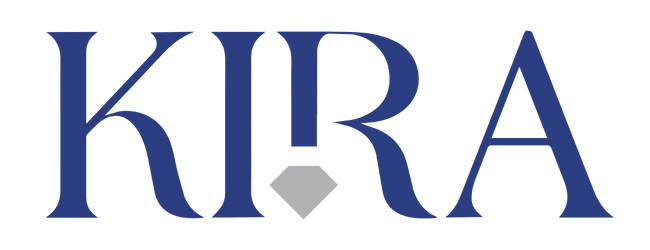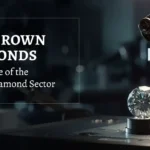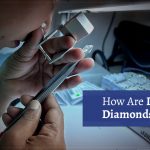Lab Grown Diamonds vs mined Diamonds: A Sustainability Perspective

When you think about diamonds, what’s the first thing that comes to mind? Maybe it’s the sparkle, the symbolism of love, or even the investment value. But these days, there’s something else to consider: sustainability. The diamond industry is at a crossroads, and the choice between lab-grown diamonds, particularly those made using Chemical Vapor Deposition (CVD) technology, and traditional mined diamonds isn’t just about looks or cost anymore—it’s about ethics and environmental impact.
CVD diamond manufacturing, a modern and innovative process, offers an alternative to the long-established practise of mining mined diamonds. This introduction of sustainable lab grown diamonds has sparked a significant conversation within the industry, especially among businesses, about the environmental and ethical implications of diamond sourcing.
But what does this really mean for you, the consumer? Well, it means that when you choose a lab-grown diamond, you’re making a choice that aligns with a growing emphasis on sustainability and ethical sourcing. Let’s dive deeper into why this is such a big deal.
This article delves into the nuances of CVD and natural diamonds, offering insights into making ethical choices in the diamond industry.
Lab Grown Diamonds vs Mined Diamonds: A Sustainability Perspective
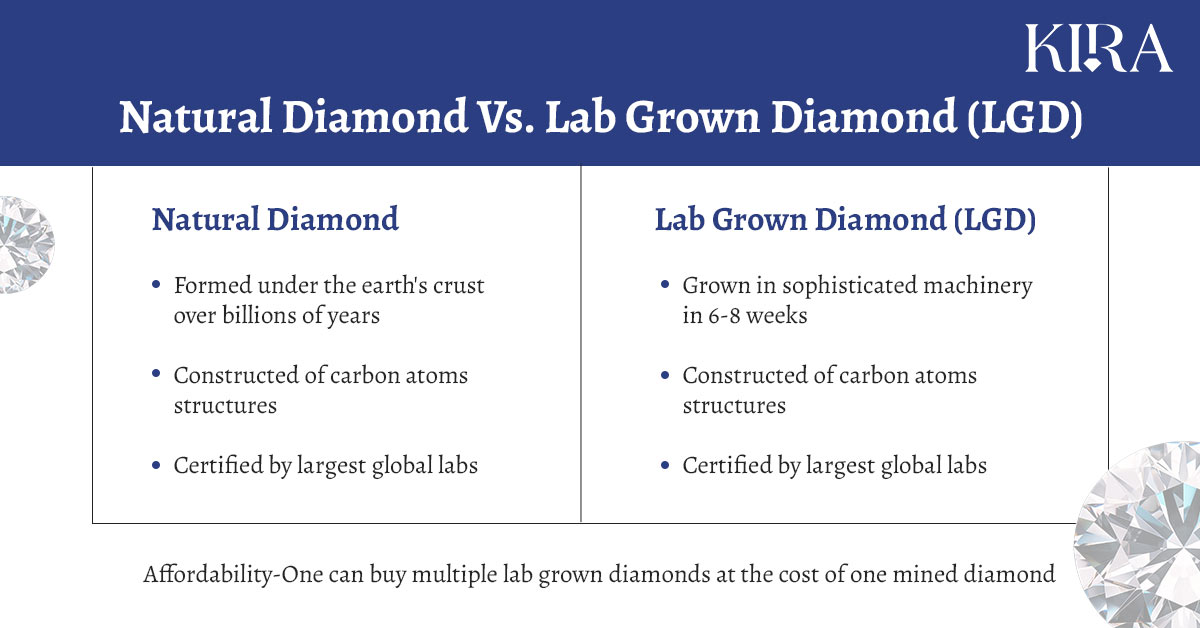
In assessing the sustainability of lab-grown diamonds versus mined diamonds, it’s crucial to understand the distinct processes behind their creation and the resulting environmental impact. Lab-grown diamonds, especially those produced using the CVD method, represent a significant advancement in sustainable practises. This technology allows for the creation of diamonds in a controlled laboratory setting, reducing the need for extensive mining operations.
mined diamonds, while possessing a unique allure and history, come with considerable environmental costs. The mining process can lead to substantial land and ecosystem disruption, high water usage, and carbon emissions. In contrast, the production of lab-grown diamonds, particularly through CVD, often involves lower emissions and less resource-intensive methods.
The choice between lab-grown and mined diamonds isn’t just a matter of aesthetics or cost; it’s increasingly becoming a decision about ethical and environmental responsibility.
Sustainability in Diamond Production
Sustainability in diamond production is a multifaceted issue that encompasses the environmental impact of mined diamond mining and the carbon footprint and energy efficiency of lab-grown diamonds, particularly those created using CVD technology.
The mining of mined diamonds is often associated with significant environmental challenges. Key concerns include
- Land degradation:Large-scale land disturbances that can result in soil erosion and loss of mined habitats.
- Ecological disruption:Mining operations can destroy local ecosystems, threatening biodiversity.
- High carbon emissions:The heavy machinery used in mining, along with transportation, contributes significantly to greenhouse gas emissions.
Lab-Grown Diamonds: A More Sustainable Option
Lab-grown diamonds, especially those created using the CVD method, present a different environmental profile. While they do have a carbon footprint—primarily due to the energy required for production—this footprint is generally much lower than that of mineddiamond mining.
For instance, the CVD process is more energy-efficient and less resource-intensive. And some companies are even taking steps to reduce their environmental impact further. Take Kira, for example. They’re leading the charge in sustainable energy adoption by harnessing 25 megawatts of solar power, ensuring their diamond production is powered by 100% renewable energy. This kind of innovation is a progressive step towards a more sustainable diamond industry.
Resource Utilization in Diamond Production
The utilization of resources in the production of lab-grown diamonds compared to natural diamonds presents a stark contrast, especially in terms of land use, water consumption, and the impact on ecosystems.
Land Use: Lab-Grown vs. Mined Diamonds
One of the starkest contrasts between lab-grown and mined diamonds is the amount of land required. Diamond mining involves massive land excavation, leading to habitat destruction and ecological damage. In contrast, the CVD process happens entirely in a lab, minimizing the physical footprint on the land.
Water Consumption: A Key Differentiator
Water is another crucial resource where lab-grown diamonds have the upper hand. Mining mined diamonds is incredibly water-intensive, from the extraction process to the cleaning and sorting stages. Lab-grown diamonds, on the other hand, require far less water, further reducing their environmental impact.
Impact on Ecosystems: A Safer Choice
The extraction of mined diamonds often results in significant ecosystem disruption. Local wildlife and plant life can be severely affected by the mining activities. Lab-grown diamonds, produced in a controlled environment, have a much smaller impact on surrounding ecosystems.
Ethical Considerations
The Dark Side of Mined Diamonds: Conflict Diamonds
When you buy a diamond, the last thing you want to worry about is whether it contributed to conflict or human suffering. Unfortunately, the history of diamond mining is marred by the issue of conflict diamonds—stones that have been mined in war zones and sold to finance armed conflict. This dark aspect of the industry has led to severe human rights abuses.
Fair Labor Practices in Lab-Grown Diamond Production
Lab-grown diamonds offer a more ethically sound alternative. The controlled lab environments ensure fairer labor practices, with better working conditions and higher standards of occupational health and safety compared to traditional mining settings. As consumers, supporting these ethical practices can make a real difference in the lives of workers around the world.
Energy Consumption
Comparing the Energy Footprint
Energy consumption is a critical factor in the sustainability of diamond production. Diamond mining is highly energy-intensive, relying on heavy machinery and extensive transportation networks. In contrast, lab-grown diamonds primarily require electricity for their production.
Some lab-grown diamond producers, like Kira, are taking steps to further minimize their environmental impact by using renewable energy sources. From solar and wind power to hydropower, these companies are setting a new standard for sustainability in the industry. Imagine buying a diamond that was created using the power of the sun—talk about a bright idea!Wind Energy: Wind turbines can be employed to generate clean electricity, making use of wind farms as sustainable and eco-friendly sources of energy for diamond production.
Kira leads the charge in sustainable energy adoption by harnessing 25 megawatts of solar power, ensuring their diamond production is powered by 100% renewable energy.
Carbon Neutral Diamond Production: The Future
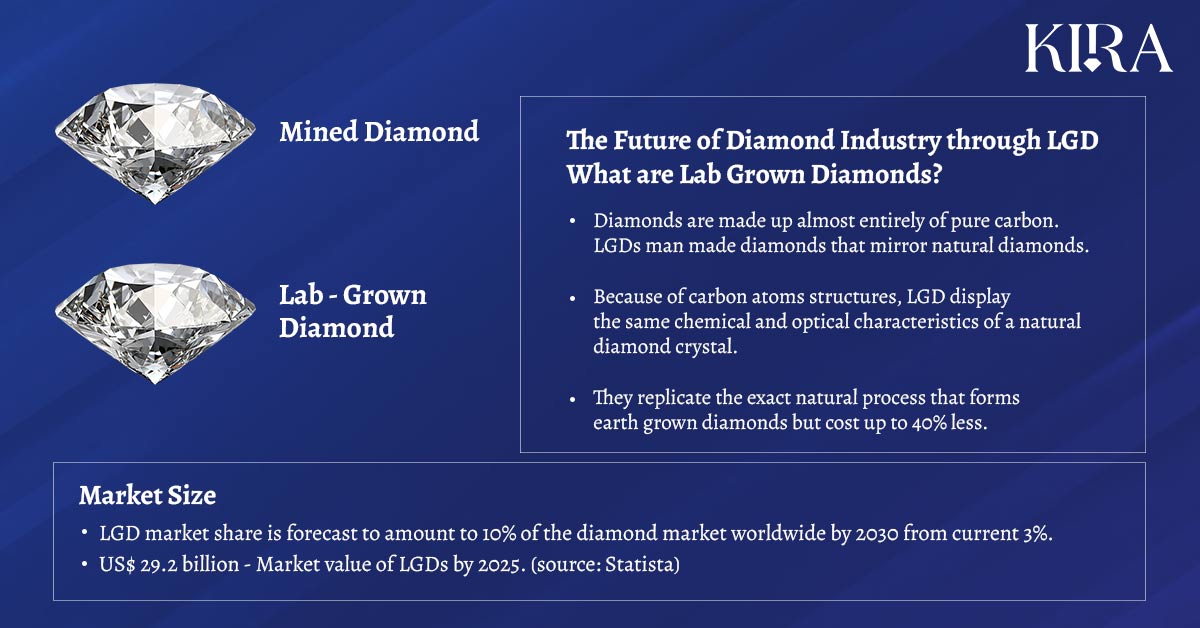
The diamond industry is on a journey toward carbon-neutral production. Some companies are investing in carbon offset initiatives, such as reforestation projects that absorb carbon dioxide, effectively neutralizing their emissions. As consumers become more environmentally conscious, these efforts are likely to gain more traction, pushing the industry toward a more sustainable future.
Waste Management
Managing Waste: A More Sustainable Approach
Waste management is another area where lab-grown diamonds have the edge. Mined diamond mining generates a significant amount of waste, including overburden (rock and soil removed during excavation) and tailings, which can lead to environmental contamination. Lab-grown diamond production, particularly through the CVD process, generates far less waste and places a greater emphasis on recycling and reusing materials.

Get Your Kira Mobile Apps Now On The App Store & Google Play!
Consumer Awareness
Consumer awareness in the diamond industry is a pivotal driver of sustainable practices and ethical choices.
Educating Consumers: Knowledge is Power
As consumers, we have more power than we often realize. By educating ourselves about the ethical and environmental implications of our choices, we can drive change in the industry. Reputable jewelers, online resources, and industry initiatives all play a role in ensuring that consumers have access to accurate information.
Choosing Environmentally Friendly Options
When it comes to making a purchase, look for certifications like the Kimberley Process, which ensures conflict-free sourcing. Consider opting for sustainable lab-grown diamonds,especially those produced using renewable energy sources. By making these choices, you’re not just buying a diamond—you’re supporting a more sustainable and ethical industry.
Cost and Market Trends
The Growing Market for Lab-Grown Diamonds
Lab-grown diamonds are gaining popularity, particularly among younger consumers. The global market for lab-grown diamonds was valued at $10.8 billion in 2022, and it’s expected to nearly double by 2032. This shift is being driven by a combination of environmental consciousness and the cost advantage of lab-grown diamonds which are typically more affordable than their mined counterparts.
The Future of Diamond Buying
As the market for lab-grown diamonds continues to grow, it’s likely that we’ll see even more innovations in sustainability and ethical sourcing. Whether you’re looking for a budget-friendly option or a diamond with a smaller environmental footprint, lab-grown diamonds offer a compelling combination of value and responsibility.
CONCLUSION
In the end, the choice between lab-grown and mined diamonds is about more than just sparkle and price—it’s about making a decision that aligns with your values. At Kira, we’re proud to be at the forefront of this transformation, offering certified lab grown diamonds that are not only beautiful but also ethically and sustainably sourced.
As the diamond industry evolves, it’s up to all of us—consumers, businesses, and producers alike—to ensure that this evolution leads to a more sustainable and ethical future. So next time you’re in the market for a certified lab grown diamonds, consider the bigger picture. After all, the real value of a diamond isn’t just in its beauty—it’s in the story it tells about the world we want to create.
Why Partner with Kira? ➣ Benefits for retailers: High-quality, ready-made jewellery and loose diamonds. ➣ Access to a vast inventory of 250,000+ diamonds in various shapes and sizes. ➣ Reliable global delivery and competitive pricing. |

